By Scott Prendergast & Lindsay Stamhuis
The Roadhouse in Twin Peaks has always acted as a kind of way station for the characters. It’s never the final destination but the place you stop at on the path to something bigger just on the horizon. It’s the place where James and Donna meet on the night Laura’s body is found before going up the mountain to bury the half-heart necklace; it’s where Agent Cooper goes with Margaret and Sheriff Truman to wait for the owls; it’s where Cooper later solves the mystery of who killed Laura. Often it doesn’t even get to be itself, as it’s doubles as the courthouse and can be turned into a community hall at the drop of a hat when there are Miss Twin Peaks pageants to host. It’s also a place where the veil between worlds seems at its thinnest, as it’s here that Cooper meets The Giant. Twice.

Seeing the Roadhouse in The Return has given fans mixed feelings. It’s an iconic location, to be sure, and seeing our favourite characters (and favourite bands) appearing within its walls has given fans a lot of joy, but its appearance in each subsequent Part is a dead giveaway that the end of the episode is drawing nigh and the dream of the last hour is about to be shattered.
But while many have been quick to dismiss The Return’s Roadhouse scenes as filler designed to prop up a marquee musical act, some of us have been trying to peer beyond the obvious to search for meaning below. I found a kindred spirit in Scott Prendergast, who sat down with me for a Q&A about his Roadhouse theory that all is not what it seems…
LINDSAY: Thanks for agreeing to this, Scott. I’m glad to get to talk about this for a little while with someone like-minded! Tell me: when did you first noticed that something was off about the Roadhouse?
SCOTT: When the new series began I was very excited to meet all the new characters. And at the end of Part 2 we got to the Roadhouse and saw Hannah and Renee for the first time. “Ah, here they are! New townsfolk!” I thought. They were sitting with Shelly Briggs, drinking, having a good time. Renee seemed like a potentially important character because she was the object of James Hurley’s affection. (I also wondered if maybe Renee was filling in for an absent Lara Flynn Boyle.) I studiously looked up both Hannah (Gia Carides) and Renee (Jessica Szohr) on imdb.com when I spotted their names in the closing credits. And then… they disappeared.
Then in Part 5, we got back into the Roadhouse and met Richard Horne. And he was dealing with two young women in the next booth. I recognized one of them, Elizabeth, as Jane Levy from Suburgatory and The Evil Dead remake. Certainly she was going to be a regular character. She’s a rising young actress in Hollywood. Richard went on to be a very significant cast member, so she would too. Even if she only had one line. But then, Elizabeth and her friend Charlotte (Grace Victoria Cox) disappeared.
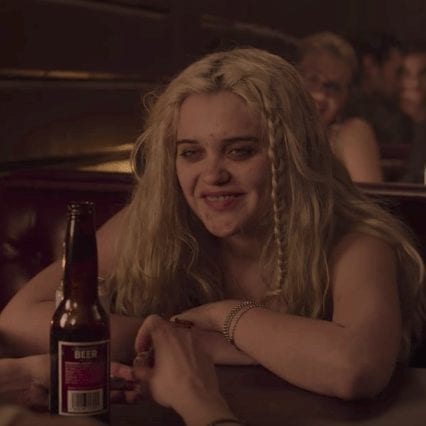 In Part 9 we met Ella and Chloe, in the disturbing scene about penguins, zebras and a nasty armpit rash. At this point I was starting to think that none of these people were going to appear more than once. These scenes were only meant to be bits of color and darkness – distractions – apparently. I couldn’t pick any clues out of Ella and Chloe’s conversation that might link them to the rest of the show, other than hints that the drug trade in Twin Peaks was still a problem, and that Ella might be serving burgers at the Double R? (she’s wasn’t).
In Part 9 we met Ella and Chloe, in the disturbing scene about penguins, zebras and a nasty armpit rash. At this point I was starting to think that none of these people were going to appear more than once. These scenes were only meant to be bits of color and darkness – distractions – apparently. I couldn’t pick any clues out of Ella and Chloe’s conversation that might link them to the rest of the show, other than hints that the drug trade in Twin Peaks was still a problem, and that Ella might be serving burgers at the Double R? (she’s wasn’t).
In Part 12, when Abbie and Natalie were gossiping on and on about people we seemingly would never meet, I decided that these Roadhouse scenes were meant to be throwbacks to the original Twin Peaks: soapy, criss-crossing plotlines and romantic intrigue boiled down to monotonous chatter. It seemed like a criticism of nighttime television. It seemed like Lynch and Frost were giving the finger to the fans who wanted the old Twin Peaks back. I couldn’t keep up with these new characters, let alone all the unknown characters they were name-dropping. These scenes were mind-numbing. And why were they (almost) always between women?
By the time we got to Megan and Sophie in Part 14, I was starting to lose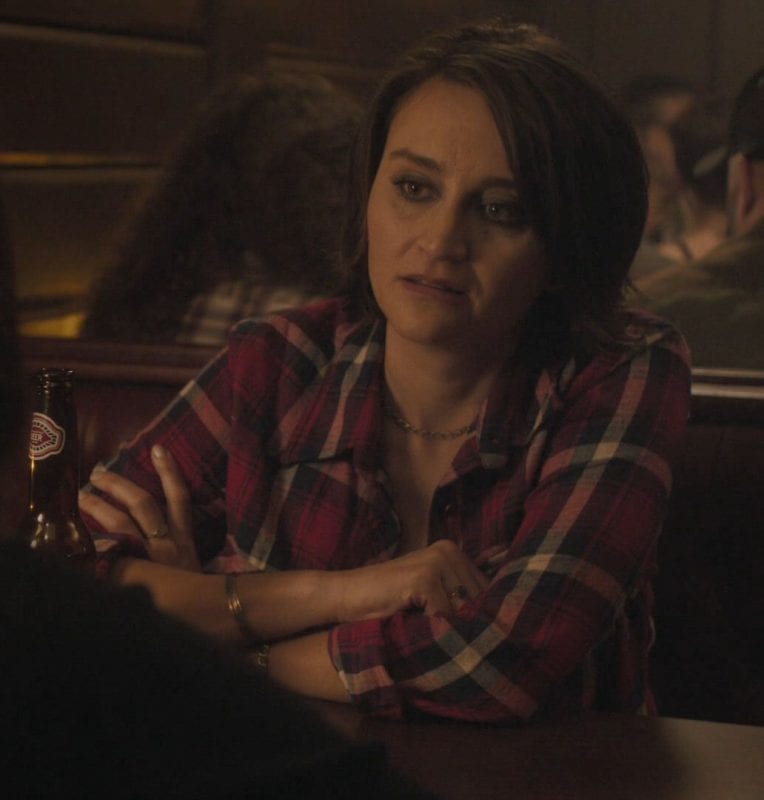 interest in these new townspeople. Was this just going to be an endless series of unknown brunette women gossiping about characters we would never meet? It seemed so pointless.
interest in these new townspeople. Was this just going to be an endless series of unknown brunette women gossiping about characters we would never meet? It seemed so pointless.
Until Sophie asked “Have you seen Billy?”
LINDSAY: I think I can trace my suspicions back to Part 9 with Ella and Chloe. Part 2 felt like a re-introduction to Shelly and James, and Part 5 seemed like a first look at the newest Twin Peaks villain, Richard Horne; I hadn’t given the rest of the characters in the “Frank Booth” any thought. But Ella and Chloe were different. It seemed at first to connect with the larger drug subplot, but as the weeks went on the drug subplot seemed to be going nowhere, I started to reevaluate…
Then came Part 12 and the intro to Audrey’s character with the barrage of new names. That late in the game, I thought it was crazy that we were being expected to remember all these characters, and my first reaction was frustration. But upon reflection I started to wonder: Perhaps what we were seeing was some kind of code. Audrey’s scenes reminded a lot of people of Invitation to Love, but even if it wasn’t literally a show-within-a-show, couldn’t it still be some kind of metaphor? A performance, in a way? Should we be looking deeper?
I thought I was crazy though, until I saw you were tweeting about all the conversations and interactions had in the booth. And Part 15 packed a wallop, too. So here we are.
SCOTT: That wallop came for me in Part 14. Once Sophie and Megan started to discuss Billy, I realized that something else was going on with these Roadhouse scenes. I knew Audrey had mentioned Billy earlier in Part 12. But I was also very aware of the name Billy because of the whole business at the Double R Diner when somebody ran in the front door and shouted “Has anyone seen Billy?” in Part 7. The closed captions identified this person as Billy, but then Sabrina Sutherland tweeted that no, that person was Bing. This is also when the diner patrons change suddenly, scrambling continuity.
In any event, hearing the name BILLY was like an alarm going off. These seemingly random nonsense conversations in the Roadhouse were suddenly connected to other parts of the show. I was on the edge of my seat. And then Sophie asked “What’s your mom’s name?” The deeply dreadful music that kicked in immediately after that question told me that something big was actually happening here. I am not exaggerating when I say that I stood up from the couch, tense as hell, waiting for Megan’s answer.
But why? It seemed so crazy. Why was the name TINA so terrifying and important? We’d never met or seen any Tina. What’s the big deal? That’s when I decided I had to chart and plot out all those Roadhouse booth conversations and see what sense I could make of them.
LINDSAY: I’ve rewatched all of the Roadhouse scenes now a couple of times and I totally agree with you that this is some weird stuff. And the Billy thing seems to be the trigger for a lot of it. I think that’s why Megan and Sophie’s conversation is so critical in Part 14 because it’s the first time Billy’s name shows up alongside Tina’s in the real world and that story starts getting shaded in a bit more. Both Billy and Tina are names that only showed up together in Audrey’s conversation with Charlie, so that has to mean something, doesn’t it?
One circle I can’t seem to square is how some characters seem mostly unrelated to the story (Chloe and Ella; Elizabeth and Charlotte; Abby and Natalie…) while other characters in the Roadhouse are involved in other larger storylines (Richard, Shelly, James and Freddie) outside of it. Because if this is some kind of dream of Audrey’s, how far does that dream extend into the “real world”? Who is real and who isn’t? It’s not so neat and tidy.
I also have to wonder about the strobe effect that shows up on stage, but only for certain bands (Trouble had it, I’m pretty sure NIN had it, and so do The Veils.) If the strobe means something Black Lodge-y is happening, then what does it mean when it flashes at the Roadhouse?
But this is me getting way ahead of myself. Let’s back it up: what sense have you managed to make out of the Roadhouse booth conversations?
SCOTT: In my original chart I was just trying to keep track of every conversation we heard in the Roadhouse booths. I started to realize there was a difference between the booths, and that the Frank booth is where all the mysterious stuff was taking place. And while I can’t say I’ve made any “sense” out of these scenes, it did occur to me that we are meant to be numbed and lulled by the monotony of them. It’s near impossible to keep track of so many unknown characters, so why try? Just let it wash over you as gossipy small town chatter. Maybe Lynch/Frost want us to discount the importance of these scenes. And then all of a sudden, the names Billy and Tina pop up. And where have we heard these names before? From Audrey. All of the unknown characters talked about in the Frank booth are now linked to all the unknown characters talked about by Charlie and Tina. Worlds collide!
Now that we know who Chuck is, here’s my updated chart on the “Frank” booth. Part 15 updates in green (for Freddie’s glove) #twinpeaks pic.twitter.com/dqj587Gdiu
— Scott Prendergast (@ScottyTheP) August 21, 2017
LINDSAY: So let’s go there then: how do you think Audrey Horne fit into all of this? A lot of fans have really been upset by her appearance in The Return. She is one of the original series’ most beloved characters, and to see her returned to us after a 25 year absence married to a limp noodle of a husband, hysterical over an unseen lover, and seemingly trapped inside her house…well, even I chafed at her characterization and I’m such a fan of outside-the-box thinking. But now I love that she’s had only three brief scenes and she’s suddenly seems super important to the plot! Some of the fan theories springing up around Audrey have been fascinating, so I don’t think I’m alone in thinking this. You must have a theory about her role too…
SCOTT: I was among those who was upset that Audrey did not appear right away in the new season. And my response to her initial appearance was that they had turned her into the modern day Catherine Martell: wealthy battle-axe, sleeping around, married to someone “beneath her station” and belittling him ruthlessly. It was very Pete and Catherine. And surprisingly, the backlash to Audrey’s return was huge. So many people tweeting and blogging: THIS IS NOT MY AUDREY HORNE! No one wanted to accept that the queen of the original series had been reduced to THIS and married to HIM.
But Part 13 went deeper. Surprisingly, Audrey was still arguing with Charlie about the same thing. Seemingly in the same room, in the same spot. And we got the feeling that her character is not OK, that she is distraught, having some sort of breakdown. The line that still baffles and haunts me is Charlie saying to her: “Do I have to end your story too?” Such a mysterious and ominous threat. Does Charlie have some cosmic power over Audrey? Could he end her storyline/her life?
Of course, the backlash against the new Audrey Horne quickly died down. Now people were saying “Fenn was so fantastic!” and “I am seriously worried about Audrey!” Lynch and Frost know what they are doing. They are teasing us. They KNOW we want Audrey. But they are the masters at not giving us what we want. Masters of giving us what we want but in a way we didn’t know we wanted.
So the two mysterious worlds collided. The Roadhouse nonsense is overlapping with Audrey’s bizarre predicament. What can it mean?
LINDSAY: Well, there’s the coma theory…
SCOTT: Yes, one of the current theories is that Audrey is STILL in a coma (from the bank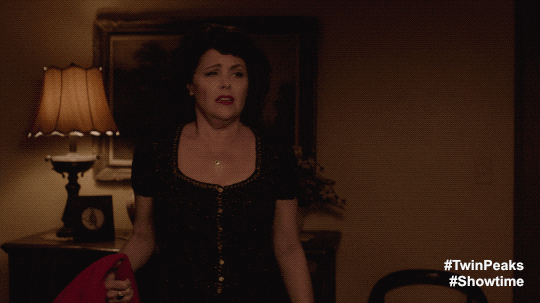 explosion) and these scenes with Charlie are a dream. She is lost inside a world in her head. Maybe that explains why all the furnishings in her world are vintage, and why Charlie has a rotary phone. But if that’s true, if this is a dream, then how does she know about Billy and Tina? Perhaps they are also part of the dream. Which means the Roadhouse scenes are also part of the dream? But we’ve seen Shelly and James in the Roadhouse. Are they part of the dream too? Is the whole town a dream? Maybe those random roadhouse characters are just nurses and doctors, family and visitors, gossiping at Audrey’s bedside. And the A-list acts playing in the Roadhouse could be just music drifting in from a radio. Is this entire season all just Audrey’s dream?
explosion) and these scenes with Charlie are a dream. She is lost inside a world in her head. Maybe that explains why all the furnishings in her world are vintage, and why Charlie has a rotary phone. But if that’s true, if this is a dream, then how does she know about Billy and Tina? Perhaps they are also part of the dream. Which means the Roadhouse scenes are also part of the dream? But we’ve seen Shelly and James in the Roadhouse. Are they part of the dream too? Is the whole town a dream? Maybe those random roadhouse characters are just nurses and doctors, family and visitors, gossiping at Audrey’s bedside. And the A-list acts playing in the Roadhouse could be just music drifting in from a radio. Is this entire season all just Audrey’s dream?
LINDSAY: But what if it’s only the Roadhouse scenes that are part of Audrey’s dream?
SCOTT: I just don’t see how they can make the Roadhouse scenes a part of Audrey’s dream without wiping out the entire show. The coma theory wraps up so many details and makes the whole thing easier to understand and swallow. But there are so many reasons that the coma is unlikely. And troublesome.
I just don’t think Lynch and Frost would pull a stunt like that. Or if they did, they wouldn’t drop the solution neat and clean into our laps. It would only be a murky suggestion, something for us to mull over for another 25 years. Just like the theories about the two halves of Mulholland Drive.
Another popular theory is that Audrey is in a mental institution, and that Charlie is her doctor, treating her through some form of role play. That sounds plausible. But then how does she know about Billy and Tina and Chuck? She claims to have interacted with them recently. Are they visitors to the mental institution? Which leads us back to the Roadhouse conversations: if Megan and Sophie are talking about Billy and Tina in present day – if they have recently interacted those characters – then doesn’t that put Audrey in the real world? If Audrey has spoken to Chuck, and then Chuck appears in the Roadhouse, then Audrey is a real person, not in a coma, not institutionalized. Right? Everyone seems to be in the same world and on the same page, right?
LINDSAY: I dislike the mental institution theory because it feels disrespectful to Audrey’s memory somehow to have her fall into the same category as other famous “crazy ladies” on TV. I think it’s entirely possible that these tropes can be subverted, deftly, by David Lynch and Mark Frost, so I’m not wholly opposed to it; but I have a feeling with all the timey-wimey-ness going on this season, and with this feeling that Audrey’s centrality will be key to unraveling all of this, that something supernatural is at play.
SCOTT: I agree with you. We already saw one nagging, angry wife (Frank Truman’s wife Doris) and then she turned out to be more sympathetic when we found out her tragic backstory. She’s a “difficult” woman redeemed by depression/mental health issues. Which makes me think they wouldn’t do that again with Audrey. There’s a larger story here about the portrayal of women in this new season of Twin Peaks, but that’s another article.
So then why can’t Audrey get out the door? It’s important, I think, that Charlie says to her “Existentialism 101.” The play Who’s Afraid of Virginia Woolf? is a famous existential work. It purports to be a simple play about an evening gathering between four adults. But the evening drags on and on, the play takes place outside of time. The main characters, like Charlie and Audrey, are bickering spouses. They argue, insult and undercut each other. They also spin a fictional story together, telling tales of their non-existent son. The son is named SONNY JIM (just like Dougie’s son). And then, out of spite, the husband in the play “kills” the son with a story. He ends the son’s storyline. Just like Charlie threatened to do to Audrey.
Again, I don’t really know how everything fits together or what it means. But it seems very clear that Audrey’s world and the Roadhouse are tied together. They are the missing pieces in each other’s puzzles.
LINDSAY: The Who’s Afraid of Virginia Woolf? connection is a fascinating one, and definitely worth exploring. If nothing else, it adds a nice layer of surreality over top of all of this, and a different kind of surreality than what we’re used to on Twin Peaks I think.
SCOTT: I think Who’s Afraid of Virginia Woolf? is just another reference, an homage. I don’t think it will help us decipher Audrey and the Roadhouse anymore than Otto Preminger’s film Laura helped us decipher who killed Laura Palmer.
LINDSAY: Good point. I’m finding myself drawn to the coma theory for a couple of reasons. Comas aren’t sleep but they’re like sleep, similar enough that Lynch (who loves his dream-states) could feasibly be enticed to play around with comatose characters in the way he’s playing with Audrey. Audrey could still be in a coma from the explosion at the bank or she could have fallen back into one some time after that. I feel if she is in a coma, it’s likeliest that she was awake at some point, as Richard seems to have knowledge of his mother, but without knowing more, speculation easily turns into fan fiction.
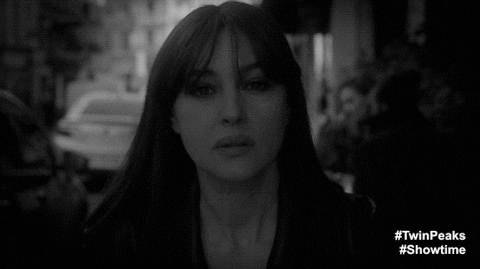 What we can say is that Lynch also loves the Wizard of Oz, and Dorothy experiences her own unconscious dream-state in which people from her own life play roles in her dream. With characters like Ruby showing up at the Roadhouse, among other links between The Return and The Wizard of Oz, it’s not a stretch to view Audrey’s situation in a similar light.
What we can say is that Lynch also loves the Wizard of Oz, and Dorothy experiences her own unconscious dream-state in which people from her own life play roles in her dream. With characters like Ruby showing up at the Roadhouse, among other links between The Return and The Wizard of Oz, it’s not a stretch to view Audrey’s situation in a similar light.
But I see your point about it feeling like a cop out. I’d argue that if anyone could pull this off in a novel way, it would be Lynch/Frost, but that’s not going to placate everyone.
SCOTT: I do think you are right about dream states and The Wizard of Oz. One of these worlds is doubling the other. One of these worlds is the circus fun house reflection of the other. And you are right about that circle you can’t square: if Audrey is real, awake and alive – and if she knows about people in Twin Peaks – knows their facts and storylines – AND if we see people in the other half of the world discussing the same people and storylines – then both parts are “true.” Right?
It’s interesting that this isn’t the only time I’ve asked this question while watching the new series. It’s very similar to the Dougie situation. I’ve wondered so many times if Cooper is simply dreaming Dougie’s whole world. Is it all a fantasy? The One Armed Man keeps telling him to wake up – so is he sleeping? But like the Roadhouse conversations, the wrench in this dream scenario is the hotel key. If Jade mailed Dougie’s hotel key back to Twin Peaks, and it arrived, then Dougie is living in the real world. He’s not dreaming. His key is real and it made it back to the Great Northern. So both halves are real. Right? If Uncle Henry in Kansas said he’d just had lunch with Glinda the Good Witch, then they both exist in the same world.
LINDSAY: Right! If things are appearing in both places, they have to be existing side by side, don’t they?
SCOTT: But maybe both worlds are real and a mysterious link connects them. Parallel worlds. That sounds like what’s going on with the lodges and the spirits. Intercourse between two worlds. Maybe that’s why we saw two different versions of the diner that night. Bing was yelling in the door, and then he was a placid customer. All the counter patrons changed. Maybe we really are watching two worlds simultaneously.
LINDSAY: Scott, you took the words out of my mouth! I’ve been a big proponent of the parallel worlds/multiverse theory ever since TSHoTP was released. It strikes me as both an elegant and a Lynchian solution to the problems of the second season (storylines that didn’t go anywhere or make any sense, unconvincing characterizations, whiplash-inducing changes in motivations, etc.) while also deepening the sense of mystery surrounding the supernatural elements that were always there. Sending a character into a liminal space like a coma (or some other dream-state. A Lodge-state perhaps?) gives the freedom to explore that.
Recentralizing Audrey also makes a huge amount of sense. She was always supposed to be an important character, and for reasons we won’t get into here she was sidelined in Season 2. And, as you’ve pointed out in your theory, Audrey was meant to be the main character in Mulholland Drive, which is commonly interpreted to be about dreams as well. Why not try and find a way to bring her back to the fore now? What a creative way in which to do this!
Also, if we’re right and Audrey is in some kind of altered state, wouldn’t it also link her to Cooper again? Let’s not be naive: they were the fan-favourite pairing, and the loss of even the most casual of friendships between them is acknowledged as one of the things that contributed to the Season 2 slip down. I’m not saying the two of them need to be married with children, but having some kind of cosmic link between the two of them in this way–psychological scars, trapped in a prison-like environment, losing track of who they are and where they are–makes a whole hell of a lot of sense.
Some more idle theorizing on the “Frank” booth, and why I think Audrey and the Roadhouse are important and connected.. #TwinPeakspic.twitter.com/mmimZXMLLq
— Scott Prendergast (@ScottyTheP) August 22, 2017
SCOTT: I would love to believe that the show is secretly bringing Cooper and Audrey back together. I don’t want to get my hopes up, but that would be an incredible conclusion. I hadn’t really thought about it until you mentioned it, but yes, both Cooper and Audrey are currently trapped in confusing worlds that might be dreams. It is obvious that Lynch and Frost like toying with us, that they are stringing this question along. When the Las Vegas FBI brought in the wrong Dougie Jones (and family) it was a sly fake out. If Dougie and Janey-E arrived in those FBI offices, then the questions are all answered: Dougie is real. He is actually in the real world. It is not a dream. He is a real person and all of his scenes in Las Vegas are taking place in the same world as Cole and Albert in South Dakota. The same goes for Audrey: if she got out that door and made it to the Roadhouse, then we know that she is alive, real, awake. Billy and Tina must be real, and Audrey is real too.
I don’t know if we can decipher this yet. I suspect there will be many more clues. Audrey’s storyline seems to be headed towards something big, now that she’s choking Charlie out. I also don’t think that Lynch and Frost will wrap up everything with a bow. I don’t think it will all be explained. I think this is going to be more like Mulholland Drive. Many many breadcrumbs, a path through the woods, but it is murky, uncertain. And every person has to find their own way.

EDIT (3 September): Scott and I have been chatting about the possible implications of the Roadhouse establishing shots (whether the neon sign is shown right side up or mirrored in the puddle outside) and the colours of the lights onstage during each band performance, as well as tossing around the idea that the conversation might be a coded reference to other people in the real world: could Billy be Cooper? Could Tina be Annie? Or Audrey herself? Is the stolen truck debacle actually a reference to the Pete Martell’s stolen truck in the S2 finale? Could Audrey be remembering the events of the Miss Twin Peaks pageant in her dream state? We’ll see what the finale tonight brings, but who knows: we may have a Part 2 discussion to this article on our hands!
Additional footnotes from Scott:
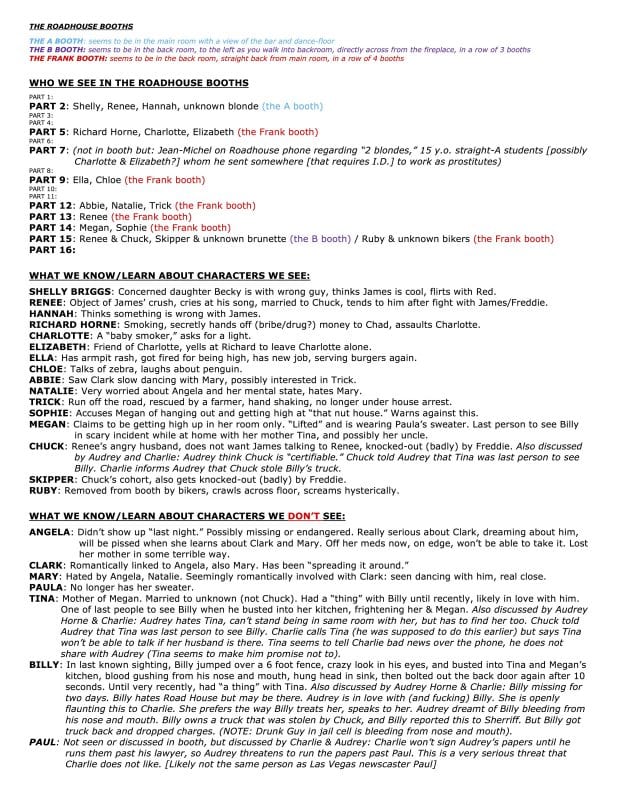 So far, I believe we have seen three different booths in the Roadhouse. I’m calling them the “A booth” where we saw Shelly, Hannah, Renee and friend having drinks with friends in Part 2 – the “B booth” where we saw Renee, Chuck, Skipper and wife (?) having drinks in Part 15 – and the “Frank booth” where we first met Richard, and all of the other random characters. The Frank booth takes its name, of course, from Dennis Hopper’s character in Blue Velvet. (I can’t take credit for that, I saw it somewhere on Twitter.) Also, the Frank booth is very dear to my heart because that’s where we saw Donna crying in the all important S2 Episode 14, when Laura’s killer was finally revealed.
So far, I believe we have seen three different booths in the Roadhouse. I’m calling them the “A booth” where we saw Shelly, Hannah, Renee and friend having drinks with friends in Part 2 – the “B booth” where we saw Renee, Chuck, Skipper and wife (?) having drinks in Part 15 – and the “Frank booth” where we first met Richard, and all of the other random characters. The Frank booth takes its name, of course, from Dennis Hopper’s character in Blue Velvet. (I can’t take credit for that, I saw it somewhere on Twitter.) Also, the Frank booth is very dear to my heart because that’s where we saw Donna crying in the all important S2 Episode 14, when Laura’s killer was finally revealed.
In a way, Billy and Tina are very much like Cooper’s hotel key. They are magical concepts that cross between two worlds. Maybe that’s what the key around Gersten’s neck is for. Maybe it opens a lockbox in a bank vault. Maybe the lockbox is filled with Sparkle, a drug that can send you back and forth between worlds.
I do also want to say that I think Trick (Scott Coffey) is a random Frank booth character to watch out for. He’s the only other male to appear in the Frank booth. Richard was the first, and we know he is evil. Trick was under house arrest for some unknown crime. He tells Abbie and Natalie that they obviously need beers when they obviously don’t (both beers are full. Is he planning to drug the beers before bringing them back to the table?) And the guy’s name is TRICK for crying out loud. I don’t trust him. Maybe he’s trafficking women with Jean-Michel. Or maybe he’s an orderly in Audrey’s coma hospital, renting her body out, and dealing drugs to people like Megan. Remember that Sophie warned her not to go up to that Nuthouse and get high.


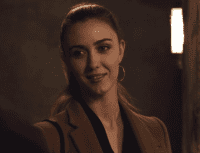
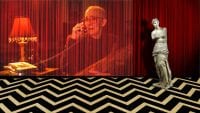

Great essay / conversation. Thanks for including your detailed notes that map the different conversations in the booths. That really helped make some sense of the connections. I love the way your conversation is mature, based on genuine knowledge of the series, rather than random conjecture, and the way it also evolves. You guys move towards a theory by talking to each other and it is great seeing this happen. More of this please, and also please update your notes after the remaining episodes.
Thanks Jon! I’m glad the format worked for you! We’re planning on doing more of these types of discussions on 25YL in the coming weeks, so it’s good to know the format works! Scott will definitely be updating his notes as necessary so I’d suggest giving him a follow on Twitter or firing an email his way (you can send it to me and I’ll forward it to him if you’d like!) Cheers!!
Like so many other people, I’ve been puzzling over Audrey’s “situation” (for lack of a better word.) While reading the above interesting article the thought occurred to me that maybe Audrey is stoned on some potent drugs. That could explain some oddities perhaps better than an ongoing coma. I looked up coma and it seems that very few people survive a coma for decades. And the ones who do have very little brain function remaining.
This is interesting…
(“I think Who’s Afraid of Virginia Woolf? is just another reference, an homage. I don’t think it will help us decipher Audrey and the Roadhouse anymore than Otto Preminger’s film Laura helped us decipher who killed Laura Palmer. “)
… because we can now say Laura wasn’t killed she just went away like Laura in the movie.
I just rewatched The Return and stumbled across this conversation. Great thoughts!! I love this parallel timeline theory and it fits with the “who is the dreamer” mystery. Meaning the dreamer is probably Cooper. He dreamed the dream by attempting to save Laura and he lives in that dream. ANYWAY, my thought about Audrey is that perhaps she is a Tulpa. Bad Coop did create a couple of others and the Diane doppelgänger was created after he raped her. We know that Richard is the product of a similar union so maybe Audrey’s foggy disposition can be simply chalked up to tulpa brain. She ain’t right. And the little glimpse we get of Audrey in a white room somewhere is the real her, lost somewhere that Coop left her. Eh, anyway…